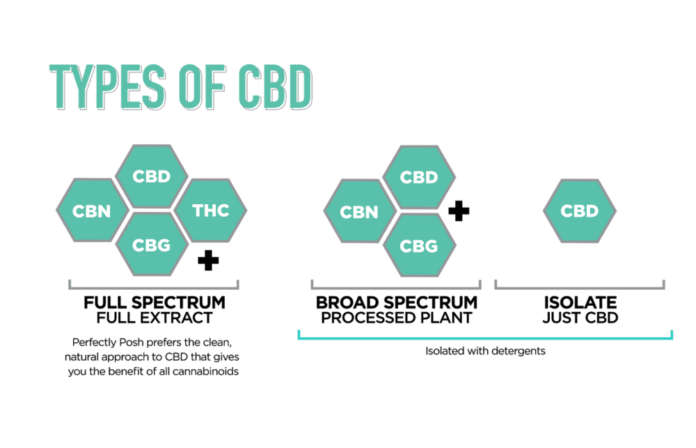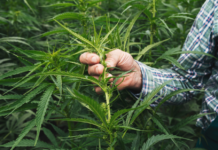Thanks to surging public interest as well as political momentum, cannabis-based compounds such as cannabidiol, or CBD have firmly entered the mainstream lexicon. At the same time, the diversity behind the broader botanical industry confuses many newcomers and even some longtime aficionados of the green arts.
To better explain and evangelize the power and holistic benefits of CBD, we laid out a quick guide on the various types of cannabidiol and their common uses. Though not a comprehensive write-up, the information provided below gives you the core breakdown of cannabis-based products. This way, you can better gauge which format is best for you.
Hemp Seed Oil

Thanks to the groundbreaking 2018 farm bill, hemp-based products have enjoyed significant mainstream attention. However, because this is still a fresh concept for most Americans, confusion remains about cannabis and how it relates to more granular compounds like hemp seed oil.
For starters, hemp is derived from the cannabis Sativa plant, as are most legal retail cannabis products, such as the ever-popular cannabidiol (CBD). Critically, hemp features a different botanical “lineage” from the material commonly referred to as “Mary Jane,” which is sourced from the cannabis indica plant.
Most prominently, the latter material includes tetrahydrocannabinol or THC for short. Responsible for the high and other psychoactive impacts, the association of THC has unfairly stigmatized the legal hemp and CBD industries. While all cannabis products are of the same species, how they are sourced and processed couldn’t be any more different.
Moreover, hemp seed oil carries unique attributes that distinguish itself from “regular” hemp. Primarily, standard hemp products and consumables feature less than 0.3% THC to meet federal mandates. This is not enough to lever a psychoactive impact, and therefore, cannabis manufacturers are legally able to market their ware as “THC free.”
However, hemp seed oil has absolutely 0% THC. Therefore, there is no possibility of any trace amount of THC showing up in your bloodstream – it simply doesn’t exist in hemp seed oil. That said, a hint of cannabidiol (CBD) is found in this oil format.
Due to its complete lack of THC, the hemp seed oil is the perfect platform for mainstream cannabis edibles, such as hemp seed milk and granola. Because of the increasing popularity of botanical solutions, manufacturers are greenlighting robustly diverse hempseed products.
Another benefit of THC-free hemp seed oil is in the emerging topicals industry. Thanks to its malleable texture and benign chemical profile, these oils are found in alternative beauty products. They also benefit the consumer who is concerned about applying exotic pharmaceutical concoctions on their bodies.
CBD Isolate

Among the most common cannabis platforms, especially for edibles and vape oil products, CBD isolate appeals to botanical users who are seeking pure exposure to cannabis. Additionally, CBD isolate products tend to be less expensive than its counterpart, full-spectrum CBD. But what exactly is isolate CBD and how does it differ from other forms of cannabidiol?
To start, CBD is one of several cannabinoids or active compounds of the cannabis plant. Currently, scientific research has unveiled over 100 cannabinoids, of which CBD is at present the most popular iteration for therapeutic use.
Other well-known cannabinoids include the notorious THCA (also known as Delta 9 THC), cannabidiol acid (CBDA), cannabigerol acid (CBGA) and cannabigerol (CBG).
With isolate CBD, end-users seek the most direct and purest form of exposure to cannabidiol. As the name implies, botanical engineers manage a rigorous process to remove all components of the cannabis plant to extract only the CBD cannabinoid. Typically, this involves removing all cannabinoids, terpenes, and flavonoids (a diverse group of phytonutrients, or plant chemicals).
Unlike free spectrum CBD – which we’ll discuss next – isolate CBD is thus pure cannabidiol. While this facilitates the most potent form of CBD, the isolated platform cannot produce what’s known as the entourage effect, or the holistic benefits associated with various cannabinoids working in conjunction with each other.
So, why choose to isolate CBD? For starters, isolate CBD is flavorless and odorless. Therefore, it doesn’t impart any flavor impact when integrated with other materials. Thus, this pure format found popularity within dabbing products or the practice of vaporizing materials using a hot nail. But recently, isolate CBD has spiked in demand among enthusiasts who mix cannabidiol with their favorite culinary dishes or beverages.
Another selling point is the potency of pure cannabidiol. Perhaps a medical professional has diagnosed a condition in which 100% CBD is most effective. In that case, isolate CBD is naturally the desired route. Plus, because of its purity, isolate CBD will not have any trace amount of THC, giving you confidence for drug tests or highly restricted jurisdictions.
Finally, many isolate CBD products – but not all – are less expensive than their full spectrum counterparts. Since CBD- and hemp-based therapies aren’t exactly cheap, isolate CBD provides a more financially welcoming transition.
Full Spectrum CBD

On the other end of the scale is full-spectrum CBD. Contrary to the isolated platform, full-spectrum CBD features all of the CBD-associated cannabinoids, terpenes, and flavonoids. As a result, if you want the most comprehensive exposure to cannabis – the entourage effect – full-spectrum CBD is the way to go.
Indeed, you’ll find that in the medical-use botanical market, many if not most manufacturers and retailers are pushing full-spectrum products. Contrary to our cynical reactions, this dynamic goes far beyond the profit motive; rather, a wealth of scientific research supports the thesis that full-spectrum CBD is more effective therapeutically than the isolate format.
The reason for this is simple and logical. Although CBD is often celebrated as a wonder compound that can soothe without imparting a psychoactive impact, the reality is that the cannabis Sativa plant is more than just CBD. As a growing body of studies indicates, non-CBD cannabinoids provide significant benefits.
Therefore, if you exhibit multiple symptoms, isolate CBD may not be as effective as the full spectrum. Also, bear in mind that isolates CBD, while pure in its ingredients, is highly processed. Those seeking natural exposure to helpful botanicals may wish to elect full-spectrum CBD products, which do not undergo rigorous extraction procedures according to Remedy Review.
However, full-spectrum CBD isn’t without its disadvantages. Botanical enthusiasts who frequently and consistently use full-spectrum CBD may have a slight risk of running positive on a THC test. Here’s the breakdown of this situation:
Under federal law, botanical companies must derive CBD products from hemp, not the THC-laden cannabis indica, or commonly known as “420.” As a result of this mandate, no CBD product may contain more than 0.3% THC. Under most use cases, this magnitude shouldn’t be a problem. However, in theory, someone who takes full spectrum CBD on an extreme basis may incur detectable levels of THC in their bloodstream.
Naturally, people who are ardently job-hunting or who live in restrictive jurisdictions may not want to change it. Ultimately, it comes down to a personal choice.
Finally, full-spectrum CBD has a naturally strong odor and flavor. For those who like the botanical profile, they may not mind it. However, cannabis is naturally pungent and therefore requires a transitioning period. And if you wish to incorporate cannabidiol into your food or beverages, the isolated platform is more likely the better choice.

Broad Spectrum CBD
Making the rounds in botanical enthusiast circles lately is broad-spectrum CBD. Somewhat of a hybrid between isolate and full-spectrum, broad-spectrum CBD offers the best of both worlds: you have the full range of cannabinoids to impart the entourage effect while giving you the exposure of zero THC exposure.
On the surface, this sounds like the perfect platform. According to nugrepublic.com, with broad-spectrum CBD, you can give your body the comprehensive health effect of the cannabis Sativa plant. Moreover, you can enjoy the compound vigorously, without fear of getting pinged on a drug test. This also helps folks who live in restricted areas but still wish to benefit fully from CBD.
But as you’ll find with cannabidiol, there is no such thing as a “perfect” pathway. As mentioned above, it truly comes down to personal preference and a balance of what you’re looking for.
One of the headwinds against broad-spectrum CBD is its lack of research. We simply don’t have enough data to pronounce whether broad-spectrum CBD is as effective as its full spectrum counterpart. That also implies that you don’t want to aggressively consume this format as you might with isolate CBD.
In other words, broad-spectrum CBD has attributes similar to isolate or full-spectrum, but possibly not identical in magnitude to either format.
Plus, broad-spectrum CBD isn’t as natural as its full spectrum counterpart. To rid this platform of THC requires processing and that may not suit every individual user’s taste or needs.
Lastly, because broad-spectrum CBD is a much more involved process, they’re rarer to find than either isolate or full spectrum. As such, you may expect manufacturers to raise the price of broad-spectrum based products.









